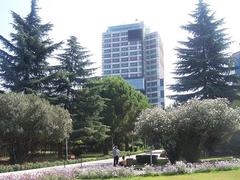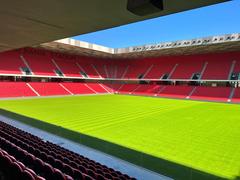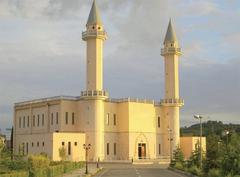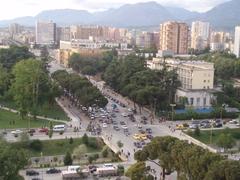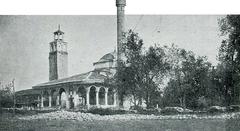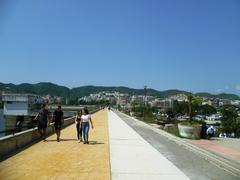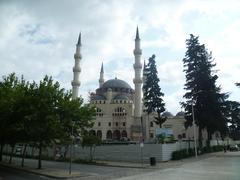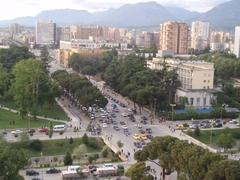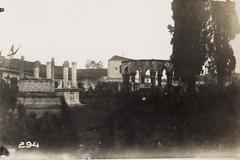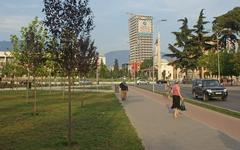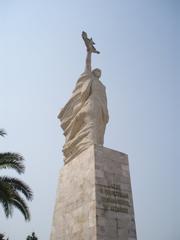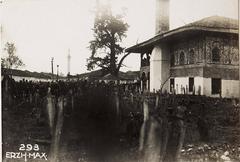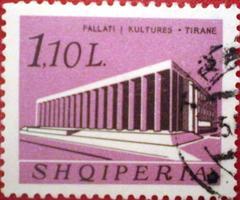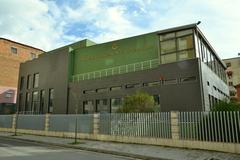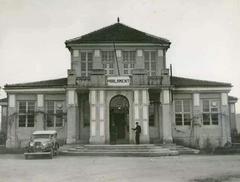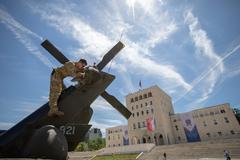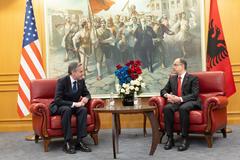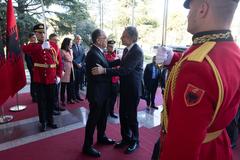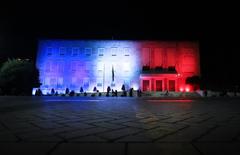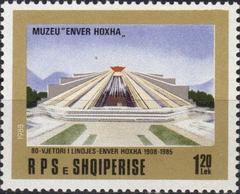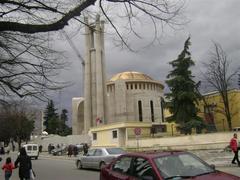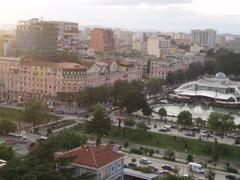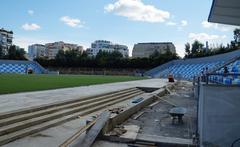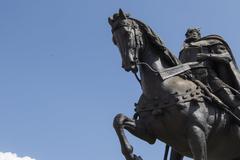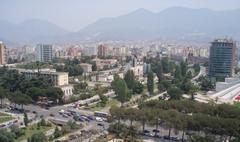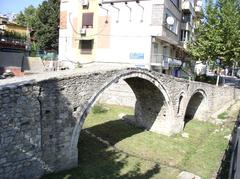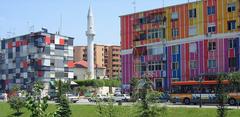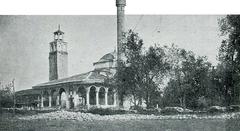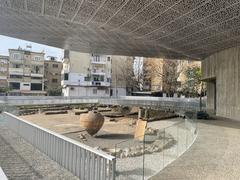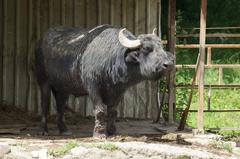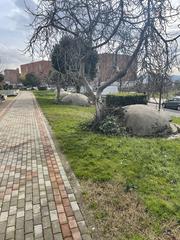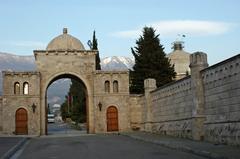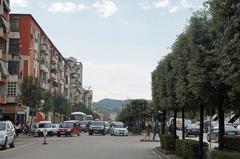National Theater of Albania Visiting Hours, Tickets, and Visitor Guide in Tirana
Date: 14/06/2025
Introduction
The National Theater of Albania in Tirana is a central pillar of the country’s cultural and historical identity, reflecting a legacy of artistic innovation and social change. From its origins as a symbol of European modernity to its transformation into a beloved Albanian cultural institution, the theater has played a vital role in shaping Tirana’s urban landscape and artistic life. This detailed guide covers the theater’s history, cultural significance, visiting information, ticketing, accessibility, and nearby attractions, ensuring you have all the essential insights for a memorable visit.
For the latest updates, ticketing options, and travel tips, consider downloading the Audiala app, which provides curated guides and real-time information on Tirana’s top cultural landmarks.
Table of Contents
- Introduction
- Origins and Construction (1938–1940)
- Architectural Innovation
- Cultural and Urban Impact
- Post-War Evolution
- Visiting the National Theater of Albania
- Demolition & Civic Response
- Contemporary Legacy
- National Theater of Opera and Ballet
- National Theater of Opera, Ballet & Folk Ensemble Visitor Guide
- Summary & Further Resources
- References
Origins and Construction (1938–1940)
The National Theater of Albania was constructed between 1938 and 1940, during the Italian occupation, as part of a larger urban vision to modernize Tirana (Architectuul). Designed by Giulio Berte and built by Pater Costruzioni Edilizia, the structure initially served as a cinema and recreational center for Italian soldiers. Its modernist design, strategic placement along Tirana’s monumental axis, and use of experimental materials positioned it at the forefront of Albania’s engagement with contemporary European architecture (7 Most Endangered).
Architectural Innovation
The theater was a hallmark of Italian rationalist style, notable for its use of “populit,” a prefabricated cement reinforced with poplar fibers and algae—a material developed during Italy’s Autarky period. The building’s design featured excellent acoustics, marble flooring, velvet curtains, and a flexible main hall suitable for various cultural events (Architectuul).
Cultural and Urban Impact
Strategically located in central Tirana, the theater influenced the city’s modernist transformation and became a reference point for subsequent public architecture. Over decades, it evolved from a venue for Italian troops to a vibrant platform for Albanian artists, hosting a wide spectrum of theatrical, cinematic, and civic events (7 Most Endangered).
Post-War Evolution
Following World War II, the theater was repurposed for the Albanian public, reflecting the changing socio-political landscape. It played a crucial role in preserving and promoting Albanian culture during both the communist era and the nation’s transition into democracy (Architectuul). The venue became a symbol of resilience and a gathering place for artistic expression and public dialogue.
Visiting the National Theater of Albania
Visiting Hours
The National Theater is typically open Monday through Saturday, from 9:00 AM to 6:00 PM. Hours may vary during special events or holidays; always consult the official website or local tourism platforms for up-to-date schedules.
Ticketing
Tickets range from 500 to 1,000 Albanian Lek (approximately $4 to $8 USD), depending on the event. Purchase tickets at the box office or online through authorized platforms linked via the official site. Discounts are often available for students, seniors, and groups.
Accessibility
The theater provides step-free access, ramps, and reserved seating for visitors with disabilities. For additional accommodations, contact visitor services prior to arrival.
Getting There & Nearby Attractions
Positioned in Tirana’s city center, the theater is accessible by public transport, taxi, or on foot. Key nearby attractions include Skanderbeg Square, the National History Museum, and the Et’hem Bey Mosque, offering a comprehensive cultural itinerary.
Special Events
The theater regularly hosts performance festivals, workshops, and civic events. Stay informed by subscribing to the theater’s newsletter or following their social media channels for updates on upcoming programs.
Demolition & Civic Response
From the early 2000s, the theater faced threats of demolition amid urban redevelopment plans. In 2018, proposals for a new complex designed by the Bjarke Ingels Group (BIG) triggered widespread protests and campaigns by artists, heritage organizations, and citizens (7 Most Endangered). Despite these efforts, the historic building was demolished on May 17, 2020, during the COVID-19 lockdown (Seestage). The event remains a pivotal moment in Albania’s cultural and urban history.
Contemporary Legacy
The National Theater is a symbol of Albania’s cultural endurance and ongoing dialogue around heritage, modernization, and public space. The new theater, designed by BIG, is intended to revitalize Tirana’s performing arts scene with state-of-the-art facilities and accessible public spaces (BIG).
National Theater of Opera and Ballet: History & Visitor Information
Historical Evolution and Modern Significance
Established in 1953, the National Theater of Opera and Ballet (TKOB) is Albania’s premier venue for opera, ballet, and symphonic music. Originally operating within the University of Arts, TKOB moved to its current home in the Palace of Culture on Skanderbeg Square, where it became a central institution for nurturing national talent and presenting international classics (www.tkob.al; Wikipedia).
Visiting Hours & Ticketing
- Box Office: Open Tuesday–Sunday, 10:00 AM–6:00 PM (closed Mondays).
- Performances: Generally begin at 7:00 PM, with occasional matinees on weekends.
- Tickets: Available at the box office, on the official website, or through authorized platforms. Prices range from 500 to 1,500 Lek ($5–$15 USD).
Accessibility
The theater is wheelchair accessible with ramps, elevators, and designated seating. Hearing assistance devices are available upon request.
Nearby Attractions
Located on Skanderbeg Square, TKOB is steps from the National History Museum, Et’hem Bey Mosque, and vibrant cafés, making it ideal for pairing a performance with sightseeing.
National Theater of Opera, Ballet, and Folk Ensemble Visitor Guide
Location & Access
The theater is situated in the Palace of Culture at Sheshi Skënderbej, Pallati i Kulturës 1, 1000 Tiranë (Vizito Shqip). It is easily accessed by public transport, airport shuttle, or taxi. Limited paid parking is available in nearby lots.
Facilities
Modern amenities include climate control, enhanced acoustics, step-free access, elevators, and accessible restrooms. The foyer has a cloakroom, bar, and souvenir kiosks.
Dress Code & Etiquette
Smart-casual or semi-formal attire is recommended. Photography and recording during performances are prohibited.
Visitor FAQs
When is the box office open?
Weekdays 10:00–18:00; two hours before performances on weekends and festival days.
How do I buy tickets?
Tickets are available at the box office, online, and from authorized partners.
Is the theater accessible for those with disabilities?
Yes, including step-free access, elevators, and accessible restrooms.
Is there parking?
No dedicated parking, but public lots are nearby.
Are guided tours available?
Occasionally, by arrangement; contact the box office for details.
Summary
The National Theater of Albania and the National Theater of Opera and Ballet are cornerstones of Albania’s cultural landscape. While the original National Theater building no longer stands, its legacy endures through ongoing performances, civic memory, and the development of new cultural facilities (7 Most Endangered; Seestage).
Located at the heart of Tirana, these institutions offer visitors a blend of history, art, and modern performance, with proximity to major historic sites. To fully experience Albania’s cultural vibrancy, plan your visit using official resources and tools like the Audiala app.
References
- National Theater of Albania – Architectuul
- National Theater of Albania – 7 Most Endangered
- National Theater of Albania – Wikipedia
- National Theater of Albania – Seestage
- National Theater of Albania – Bjarke Ingels Group (BIG)
- National Theater of Opera and Ballet – Official Website
- National Theater of Opera, Ballet, and Folk Ensemble – Vizito Shqip
- Audiala App
